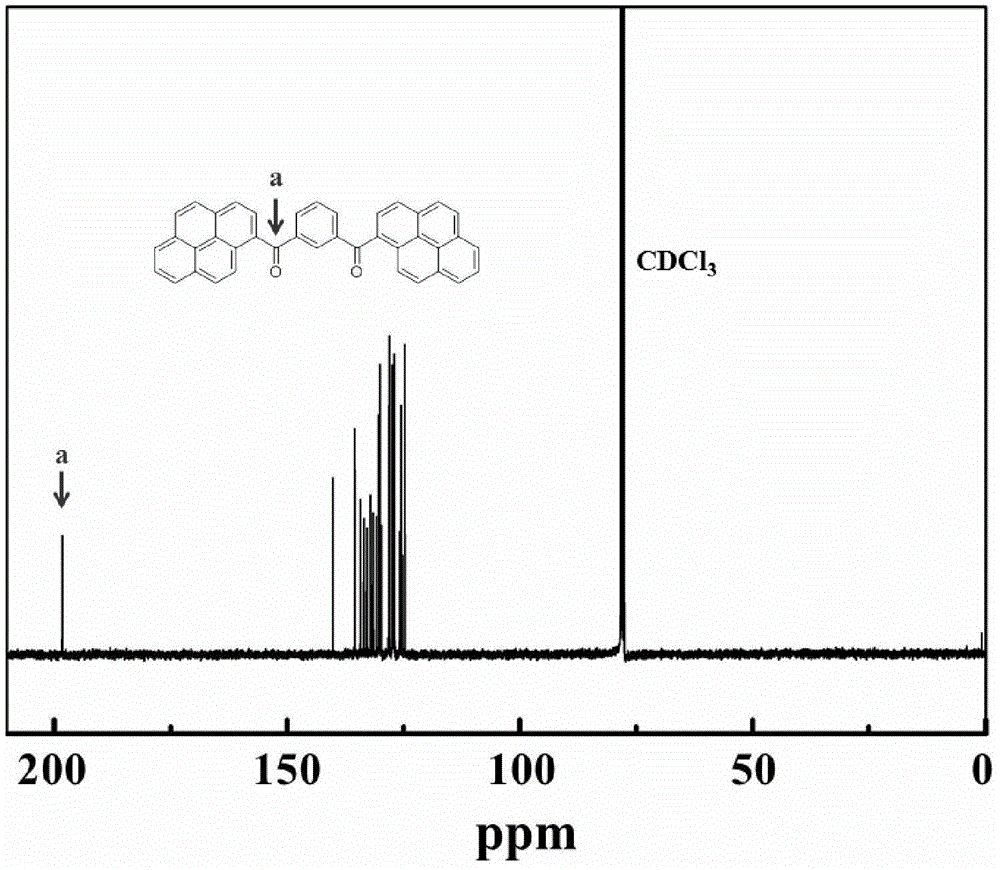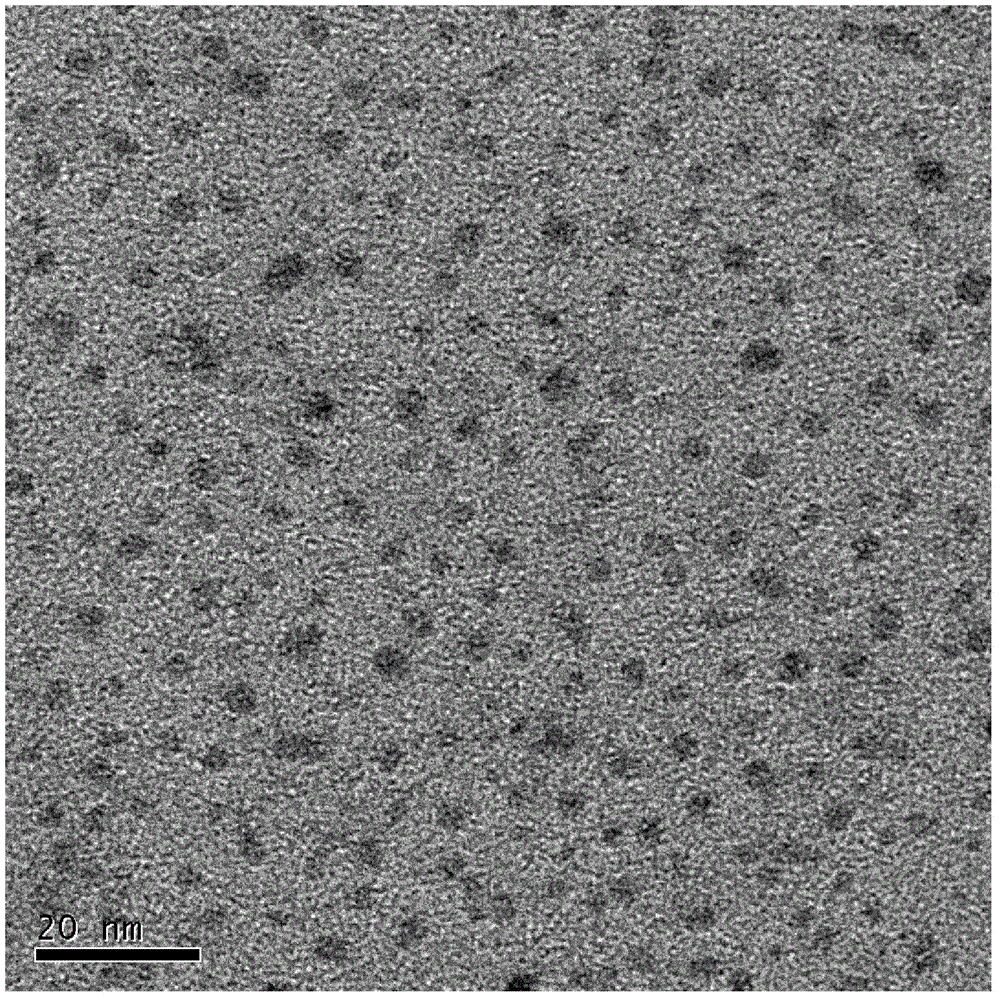A kind of bispyrene compound and its fluorescent nano-aggregate and application
A technology of fluorescent nanometers and compounds, applied in the direction of condensation preparation of carbonyl compounds, chemical instruments and methods, luminescent materials, etc., can solve the problems of poor optical stability, rare research reports, poor anti-bleaching performance, etc., and achieve excellent anti-photobleaching properties, high chemical stability, effect of good optical stability
- Summary
- Abstract
- Description
- Claims
- Application Information
AI Technical Summary
Problems solved by technology
Method used
Image
Examples
preparation example Construction
[0047] 2 Preparation of nanoaggregates
[0048] Dissolve 5 mg of compound (a) in 10 mL of DMSO solvent, quickly inject this solution into 90 mL of ultrapure water with a syringe, and sonicate for 30 minutes to obtain a fluorescent nano-aggregate dispersion. image 3 It is a transmission electron micrograph of the nano-aggregates prepared in this embodiment.
[0049] 3 Lysosome co-localization
[0050] KB cells were cultured in DMEM (Invitrogen) with 10% PBS (Invitrogen). The day before the confocal fluorescence imaging experiment, the cells were seeded in a dedicated cell confocal culture dish. The next day, 25 μM of compound (a) nanofluorescent aggregates were added thereto, and kept at 37 °C and 5% CO 2 Under conditions, incubate for 3 hours, and then wash 3 times with phosphate buffer solution. Then add 10 μM lysosome probe compound LysoTracker Red (Beiyuntian) and keep it at 37°C and 5% CO 2 Incubate for 1 hour, and then wash with phosphate buffer solution 3 times, th...
Embodiment 2
[0051] Embodiment 2 is with R structure as as an example
[0052] 1 Synthesis of bispyrene compounds
[0053] Friedel-Crafts acylation reaction of pyrene: Dissolve 10mmol pyrene (2g) in 30mL carbon disulfide and put it in a 50mL single-necked bottle, add 7.5mmol 2,6-pyridine dicarboxylic acid chloride (1.53g), and cool to 0 in an ice bath ℃, add 20mmol aluminum oxide (2.64g), heat and reflux for 12 hours, pour the product into 100mL ice water and stir for 2 hours after cooling, separate the liquid with dichloromethane, dry and filter the organic phase through anhydrous magnesium sulfate, and then recrystallize. 1.88 g of the product (b) was obtained as yellow flaky crystals, and the yield was 71%. Figure 5 It is the nuclear magnetic spectrum (1H NMR) of the bispyrene compound prepared in this embodiment; Image 6 is the nuclear magnetic spectrum (13C NMR) of the bispyrene compound prepared in this example.
[0054] 2 Preparation of nanoaggregates
[0055] Dissolve 5 mg ...
Embodiment 4
[0063] Embodiment 4 is with R structure as as an example
[0064] 1 Synthesis of bispyrene compounds
[0065] Friedel-Crafts acylation reaction of pyrene: 10mmol pyrene (2g) was dissolved in 30mL carbon disulfide, and placed in a 50mL single-necked bottle, and 25mmol of (5.125g), cooled to 10°C in an ice bath, added 20mmol aluminum oxide (2.64g), heated and refluxed for 20 hours, cooled the product and poured it into 100mL ice water and stirred for 8 hours, separated with dichloromethane, organic The phase was dried and filtered through anhydrous magnesium sulfate, and then recrystallized to obtain 4.5 g of product (b) as yellow flaky crystals, with a yield of 83%.
[0066] 2 Preparation of nanoaggregates
[0067] Dissolve 2 mg of compound (c) in 10 mL of acetone solvent, inject this solution into 90 mL of ultrapure water with a syringe, and sonicate for 60 minutes to obtain a fluorescent nano-aggregate dispersion.
PUM
 Login to View More
Login to View More Abstract
Description
Claims
Application Information
 Login to View More
Login to View More - R&D
- Intellectual Property
- Life Sciences
- Materials
- Tech Scout
- Unparalleled Data Quality
- Higher Quality Content
- 60% Fewer Hallucinations
Browse by: Latest US Patents, China's latest patents, Technical Efficacy Thesaurus, Application Domain, Technology Topic, Popular Technical Reports.
© 2025 PatSnap. All rights reserved.Legal|Privacy policy|Modern Slavery Act Transparency Statement|Sitemap|About US| Contact US: help@patsnap.com



